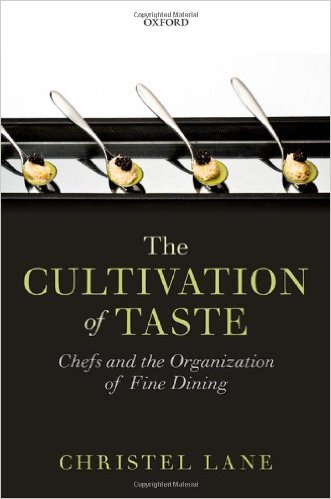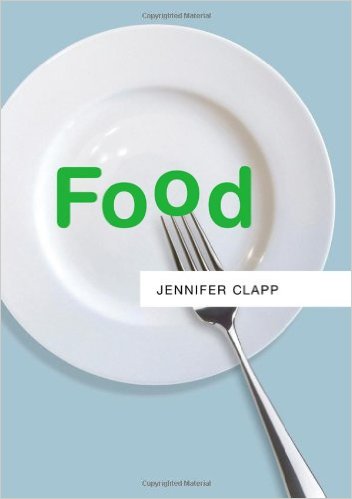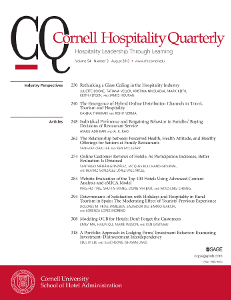Delectable Reads: An Abundance of Book Reviews and Articles About Food
Still thinking about all of the delicious Thanksgiving food from yesterday? Here is a food-themed collection of book reviews and articles for you to dig into over leftovers:
 Christel Lane : The Cultivation of Taste: Chefs and the Organization of Fine Dining. New York: Oxford University Press, 2014. 368 pp. $45.00/£30.00, hardback.
Christel Lane : The Cultivation of Taste: Chefs and the Organization of Fine Dining. New York: Oxford University Press, 2014. 368 pp. $45.00/£30.00, hardback.
Read the review by Michaela DeSoucey of North Carolina State University, published in the September 2015 issue of Administrative Science Quarterly:
In today’s world, eating out is serious business. And Christel Lane’s new book, The Cultivation of Taste, is a serious—and engaging—scholarly investigation into the business of the culinary industry. Broadly, her comparative analysis of the world of fine-dining chefs and top restaurants in Britain and Germany is a study of the contemporary social organization and business of taste. It unites arguments from organizational theory, the sociology of
culture, and economic sociology. Lane, a sociologist, takes the reader on a behind-the-scenes tour, spanning organizational and industry structures, the occupational careers and attitudes of elite chefs, and the taste-making power of gastronomic guides, namely the prestigious Michelin Guide. Her choice of Britain and Germany as case studies was a purposeful one; both are newcomers to fine dining and equally smaller than the French sector. Yet, despite lacking rich histories of haute cuisine, both have seen stratospheric public interest in home-grown fine dining—and all that neo–fine-dining entails in the 21st century—in the last few decades.
 Clapp, J. (2012). Food. Malden, MA: Polity Press.
Clapp, J. (2012). Food. Malden, MA: Polity Press.
Read the review by Josh Brem-Wilson of Universitat Oberta de Catalunya, published in the September 2012 issue of Organization & Environment:
In recent years, Jennifer Clapp, Chair of Global Environmental Governance at Waterloo’s Centre for International Governance Innovation, has established herself as a food analyst of international repute, her work on the dynamics of transnational corporation (TNC) participation in agrifood systems and food volatility being two recent highlights. That she would have been chosen to contribute this volume to Polity’s Resource series should therefore come as no surprise. The timeliness of this text goes without saying—the broad range of themes and contentions clustered under “food policy issues,” whilst perhaps not garnering the same degree of elite attention that they were just 3 or 4 years ago, continue to command specialist and public awareness alike. At the same time, however, the complexity of the issues and of the “system” within which they are contested, and the speed with
which new issues emerge onto the radar, sets the bar of entry within this field of human endeavour quite high. Thus, as Clapp states in her introduction: “This book aims to contribute to a fuller understanding of some of the key forces that influence and shape the current global food system,” focusing in particular on “the interface between the international political and economic dimensions of the system—what I refer to as the ‘world food economy.’”
 Read the article, “The Price You Pay: Price-setting as a Response to Norm Violations in the Market for Champagne Grapes” by Amandine Ody-Brasier and Freek Vermeulen, published in the March 2014 issue of Administrative Science Quarterly. The abstract:
Read the article, “The Price You Pay: Price-setting as a Response to Norm Violations in the Market for Champagne Grapes” by Amandine Ody-Brasier and Freek Vermeulen, published in the March 2014 issue of Administrative Science Quarterly. The abstract:
Contrary to the general view that markets are shaped by economic forces, bargaining power, and the prior relationships between exchange partners, this paper posits that markets can sometimes also be purely socially constructed, in the sense that prices can vary irrespective of the economic value embedded in the exchange. Building on insights from the literature on categories, we argue that sellers may react to violations of local norms on the part of particular buyers by charging them higher prices. Sellers thus provide economic benefits, in the form of lower prices, to buyers who closely adhere to the category’s norms. We test these ideas using data on the market for Champagne grapes, examining the exchange between grape growers (the sellers) and the 66 houses that make the sparkling wine (the buyers). Interviews and survey data informed us that growers have clear, normative ideas about what a Champagne house should look like and do: houses that are no longer headed by a descendant of the founder, are not located in one of the traditional Champagne villages, are relative newcomers to the industry, are part of a corporate group, supply supermarket brands, operate winemaking subsidiaries abroad, or acquire their own vineyards are all viewed in a negative light. Our models provide strong support for our prediction, showing that the prices different organizations are charged for their purchases depend substantially on whether they meet local expectations for who they are and what they do. Our qualitative evidence confirms that this differential pricing by growers occurs not through collusion but through a spontaneous, bottom-up process.
 Read the article, “Mobile Tablet Menus: Attractiveness and Impact of Nutrition Labeling Formats on Millennials’ Food Choices” by Maryam F. Yepes, published in the February 2015 issue of Cornell Hospitality Quarterly. The abstract:
Read the article, “Mobile Tablet Menus: Attractiveness and Impact of Nutrition Labeling Formats on Millennials’ Food Choices” by Maryam F. Yepes, published in the February 2015 issue of Cornell Hospitality Quarterly. The abstract:
Using mobile tablet technology, this study compared menu selections by millennial-age respondents to test the effects of five different menu nutrition labeling formats for attractiveness, perceived influence, and actual influence on the students’ food choices. Labeling formats presented on an iPad involved combinations of numeric caloric values, traffic-light color coding, and percentage of daily intake presented as a graphic summary. Each participant was asked to select four courses from a fine-dining restaurant menu, and each was shown one of the five nutrition labeling formats (or no information at all). Although there was no significant difference in the calorie count for the six groups, the labeling format with traffic-light color coding combined with a graphic summary of the meal’s calorie count (compared with the daily recommended intake) received the highest attractiveness ranking. This attractive graphic format also showed a significant positive correlation to its perceived influence on food choices. Overall, participants in all labeling groups indicated a strong support for inclusion of nutrition information on restaurant menus using mobile tablet technology.
 Read the interview, “The Hidden Costs of Seafood: An Interview with Muhammad Saidul Islam,” published in the September 2014 issue of World Future Review. From the introduction:
Read the interview, “The Hidden Costs of Seafood: An Interview with Muhammad Saidul Islam,” published in the September 2014 issue of World Future Review. From the introduction:
In coastal communities throughout the developing world, farmers are cordoning off swaths of beaches, lakes, and rivers to cultivate stocks of fish, shellfish, and shrimp for markets in the more affluent parts of the globe. These “aquaculture” industries, as the fish farms are known, satisfy a massive global consumer demand for seafood while bringing considerable business profits to the farmers and distributors who make their livelihoods in them. But the business carries a heavy price for the communities in which the aquaculture industries set up shop, according to Muhammed Saidul Islam, an assistant professor of sociology at Nanyang Technological University in Singapore.
Happy reading!



























































































